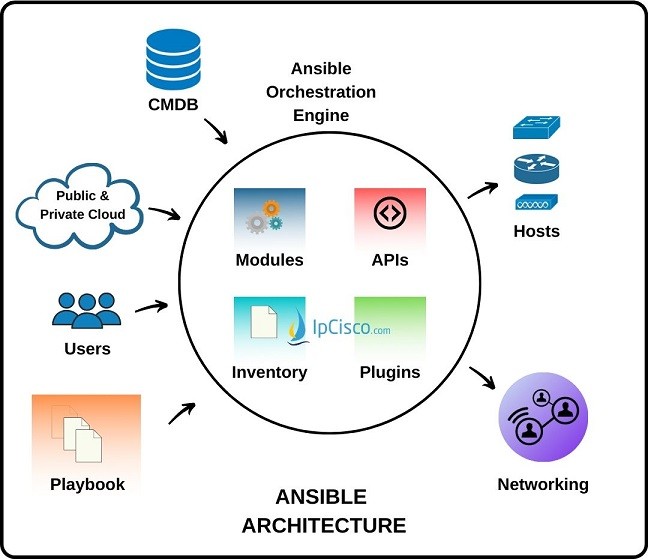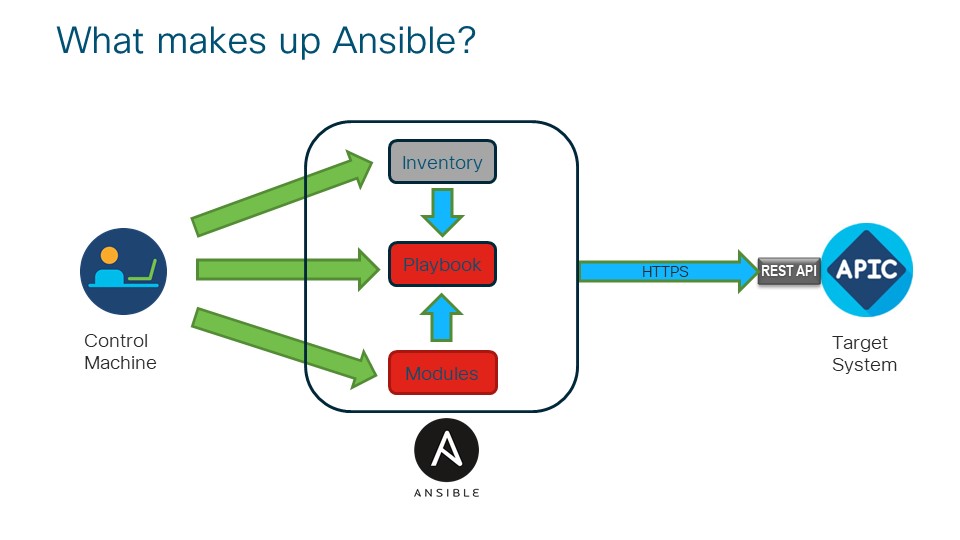Ansible Explained: A Versatile Automation Tool
Ansible is a popular open-source automation tool designed to simplify and streamline various IT operations, including configuration management, application deployment, and orchestration. The primary objective of Ansible is to automate repetitive tasks, reduce human errors, and enhance productivity across an organization’s IT infrastructure. Define Ansible: At its core, Ansible is a powerful and flexible automation engine that relies on human-readable YAML files, known as playbooks, to manage and orchestrate tasks across multiple nodes or systems. Ansible’s simplicity lies in its agentless architecture, which eliminates the need for additional software installation on managed nodes, making it a lightweight and easy-to-deploy solution.
Ansible’s extensive capabilities in configuration management enable administrators to maintain consistent system configurations, ensuring that all nodes adhere to predefined standards and policies. This consistency is crucial for organizations seeking to minimize discrepancies and maintain a uniform and secure environment.
In addition to configuration management, Ansible offers robust application deployment features, allowing developers to automate the process of deploying applications across various environments, such as development, staging, and production. By automating application deployment, Ansible reduces the risk of errors and inconsistencies, ensuring a smooth and efficient rollout process.
Ansible’s orchestration capabilities are another significant advantage, as they enable organizations to manage complex workflows and dependencies across multiple nodes and services. This feature is particularly beneficial for large-scale deployments, where coordinating tasks and ensuring seamless integration between different components is essential.
In summary, Ansible is a versatile automation tool that empowers organizations to automate repetitive tasks, maintain consistent system configurations, streamline application deployment, and orchestrate complex workflows. Its agentless architecture, human-readable playbooks, and extensive capabilities make it an ideal choice for organizations seeking to improve productivity, reduce costs, and enhance security across their IT infrastructure.
Key Concepts and Terminologies in Ansible
To gain a solid understanding of Ansible, it’s essential to familiarize yourself with some key concepts and terminologies. Here are some essential Ansible terms that will help you navigate the world of automation more efficiently: Playbooks: Playbooks are the foundation of Ansible’s automation capabilities. They are human-readable YAML files that outline the desired state of a system or a set of systems. Playbooks consist of one or more plays, which are a collection of tasks that should be executed on a specific group of hosts.
Tasks: Tasks are the building blocks of Ansible playbooks. They represent individual actions that need to be performed on managed nodes. Tasks are typically carried out using Ansible modules, which are standalone programs that can be executed on the target systems.
Modules: Modules are reusable units of code that perform specific functions in Ansible. They are responsible for carrying out tasks and interacting with the target systems. Ansible offers a wide range of prebuilt modules for managing various aspects of system administration, networking, and cloud services.
Roles: Roles are a way to organize and reuse Ansible tasks, modules, and other components. They help in creating a modular structure for playbooks, making it easier to share and reuse code across different projects. Roles can include tasks, handlers, files, templates, and variables, among other elements.
Handlers: Handlers are special tasks that are triggered by other tasks when a specific condition is met. They are typically used for managing services, such as restarting or reloading them when a configuration file is updated.
Inventories: Inventories are lists of managed nodes that Ansible interacts with. They contain information about the target systems, such as IP addresses, hostnames, and user accounts. Ansible supports various inventory formats, including INI, YAML, and even dynamic inventory sources like cloud services.
Facts: Facts are pieces of information about managed nodes, such as operating system, network interfaces, and hardware details. Ansible automatically gathers facts about target systems, which can be used in playbooks to make decisions and customize tasks.
Templates: Templates are used to create configuration files dynamically based on variables and facts. Ansible uses the Jinja2 templating engine to render templates, which can be written in various markup languages, such as HTML, XML, or plain text.
Conditionals: Conditionals are used in Ansible playbooks to make decisions based on facts, variables, or return values from modules. They enable you to create dynamic playbooks that adapt to different situations and environments.
Loops: Loops are used to iterate over a list of items and execute tasks multiple times. They can be used to manage multiple resources, such as users, packages, or services, in a single playbook.
Error Handling: Ansible provides several mechanisms for handling errors and exceptions, such as blocks, rescue, and always. These constructs allow you to control the flow of execution and manage failures gracefully.
By understanding these key concepts and terminologies, you’ll be well-equipped to write Ansible playbooks and manage your IT infrastructure more efficiently.
How Ansible Works: Architecture and Components
Ansible’s architecture and components play a crucial role in its agentless, efficient, and secure automation capabilities. Here, we’ll discuss Ansible’s basic working principle, its agentless architecture, the role of the Ansible control node, managed nodes, and the YAML format for writing playbooks. Agentless Architecture: Ansible’s agentless architecture is one of its most significant advantages. Unlike other automation tools, Ansible does not require any additional software installation on managed nodes. Instead, it relies on OpenSSH, which is already pre-installed on most Unix-like systems, for secure communication with managed nodes. This agentless approach reduces the overhead of managing and maintaining additional software on target systems, making Ansible a lightweight and easy-to-deploy solution.
Ansible Control Node: The Ansible control node is the system where Ansible is installed and configured. It acts as the central hub for managing and automating tasks across multiple managed nodes. The control node is responsible for executing playbooks, managing connections to managed nodes, and coordinating tasks.
Managed Nodes: Managed nodes are the systems that Ansible interacts with and automates. They can be physical or virtual machines, containers, or cloud instances. Managed nodes do not require any additional software installation, as Ansible uses OpenSSH for secure communication.
Ansible Inventory: Ansible inventory is a list of managed nodes that Ansible interacts with. It contains information about the target systems, such as IP addresses, hostnames, and user accounts. Ansible supports various inventory formats, including INI, YAML, and even dynamic inventory sources like cloud services.
YAML Format for Playbooks: Ansible playbooks are written in YAML, a human-readable data serialization format. YAML is easy to learn and understand, making it an ideal choice for writing Ansible playbooks. Playbooks consist of one or more plays, which are a collection of tasks that should be executed on a specific group of hosts.
Ansible’s working principle is based on the concept of “pushing” automation tasks from the control node to the managed nodes. Playbooks are executed on the control node, and the tasks are pushed to the managed nodes for execution. This approach eliminates the need for managing and maintaining agents on target systems, making Ansible a simple, efficient, and secure automation solution.
Getting Started with Ansible: Installation and Setup
To get started with Ansible, you need to install and configure it on a control node. This section provides a step-by-step guide to installing Ansible and setting up passwordless authentication with managed nodes using SSH keys. Step 1: Install Ansible on the Control Node
On most Linux distributions, you can install Ansible using the package manager. For example, on Ubuntu or Debian, you can use the following command:
sudo apt-get update && sudo apt-get install ansibleFor Red Hat, CentOS, or Fedora, use the following command:
sudo yum install ansible Step 2: Verify the Installation
After installing Ansible, you can verify the installation by checking the version using the following command:
ansible --version Step 3: Set Up SSH Keys for Passwordless Authentication
Ansible relies on SSH for secure communication with managed nodes. To set up passwordless authentication, you need to generate SSH keys on the control node and copy them to the managed nodes.
On the control node, generate the SSH keys using the following command:
ssh-keygenNext, copy the public key to the managed nodes using the ssh-copy-id command:
ssh-copy-id user@managed-node Replace “user” with the appropriate username on the managed node and “managed-node” with the hostname or IP address of the managed node.
Step 4: Verify Passwordless Authentication
To verify that passwordless authentication is working, try connecting to the managed node using SSH:
ssh user@managed-node If the connection is successful without prompting for a password, passwordless authentication has been set up correctly.
Step 5: Create an Ansible Inventory
Ansible inventory is a list of managed nodes that Ansible interacts with. Create an inventory file named “inventory” with the following content:
[managed-nodes] managed-node Replace “managed-node” with the hostname or IP address of the managed node.
Step 6: Test Ansible Connectivity
Finally, test the connectivity between the control node and the managed node using the ping module:
ansible managed-nodes -m pingIf the connection is successful, you should see output similar to the following:
managed-node | SUCCESS => { "ansible_facts": { "discovered_interpreter_python": "/usr/bin/python3" }, "changed": false, "ping": "pong" }With Ansible installed and configured, you’re now ready to start writing and executing playbooks.
Ansible Playbooks: Writing and Executing
Ansible playbooks are the heart of Ansible’s automation capabilities. They are written in YAML, a human-readable data serialization format, and define the desired state of managed nodes. In this section, we’ll illustrate the process of writing, running, and troubleshooting Ansible playbooks, including examples of basic tasks, conditionals, loops, and error handling. Writing a Basic Playbook
A basic Ansible playbook consists of a list of plays, where each play specifies a set of tasks to be executed on a group of hosts. Here’s an example of a simple playbook that installs the Apache HTTP server on a managed node:
--- - hosts: managed-nodes tasks: - name: Install Apache HTTP server apt: name: apache2 state: present Running a Playbook
To run a playbook, use the ansible-playbook command followed by the playbook file:
ansible-playbook playbook.yml Troubleshooting Playbooks
Ansible provides several mechanisms for troubleshooting playbooks, such as the -vvv flag for verbose output, the –syntax-check flag for syntax validation, and the –check flag for simulating the execution of tasks without making any changes.
Conditionals
Conditionals allow you to create dynamic playbooks that adapt to different situations and environments. Ansible supports various conditional expressions, such as when, block, and rescue.
Here’s an example of a conditional that checks if a package is already installed and skips the installation if it is:
- name: Install Apache HTTP server apt: name: apache2 state: present when: ansible_facts['packages']['apache2'] is not defined Loops
Loops enable you to iterate over a list of items and execute tasks multiple times. Ansible supports various looping constructs, such as with_items, with_fileglob, and with_lines.
Here’s an example of a loop that installs multiple packages:
- name: Install multiple packages apt: name: "{{ item }}" state: present with_items: - apache2 - vim - htop Error Handling
Ansible provides several mechanisms for handling errors and exceptions, such as blocks, rescue, and always. These constructs allow you to control the flow of execution and manage failures gracefully.
Here’s an example of a block that handles errors during package installation:
- block: - name: Install packages apt: name: "{{ item }}" state: present rescue: - name: Handle errors debug: msg: "Failed to install {{ item }}" with_items: - package1 - package2 By mastering the art of writing, running, and troubleshooting Ansible playbooks, you can automate complex tasks and streamline your IT infrastructure management.
Ansible Modules: Prebuilt and Custom
Ansible modules are reusable units of code that perform specific tasks in Ansible playbooks. They are responsible for managing various aspects of system administration, networking, and cloud services. In this section, we’ll explore the variety of prebuilt Ansible modules available and provide guidelines for creating custom modules. Prebuilt Ansible Modules
Ansible offers a rich library of prebuilt modules for managing various aspects of system administration, networking, and cloud services. These modules are designed to work seamlessly with Ansible playbooks and can be used to perform tasks such as package management, user management, service management, and file management.
Here’s an example of using the apt module for package management:
- name: Install Apache HTTP server apt: name: apache2 state: present Creating Custom Ansible Modules
While Ansible provides a wide range of prebuilt modules, there may be instances where you need to create custom modules to perform specific tasks. Custom modules can be written in Python, PowerShell, or any other language that supports JSON over standard input/output.
Here’s a basic outline of a custom Ansible module written in Python:
#!/usr/bin/python from ansible.module_utils.basic import AnsibleModule def main(): module = AnsibleModule( argument_spec=dict( name=dict(type='str', required=True), state=dict(type='str', choices=['present', 'absent'], default='present') ) ) name = module.params['name'] state = module.params['state'] # Perform custom logic here module.exit_json(changed=True, message="Custom module executed successfully") if __name__ == '__main__': main() Finding and Using Ansible Modules
Ansible modules are stored in the /usr/lib/pythonX.Y/site-packages/ansible/modules directory (replace X.Y with your Python version). You can also find a list of available modules in the Ansible documentation or by using the ansible-doc command.
To use a custom module, place it in the /path/to/your/playbook/library directory and make sure it’s executable. Ansible will automatically discover and load custom modules from this directory.
By leveraging the power of prebuilt and custom Ansible modules, you can automate complex tasks and streamline your IT infrastructure management.
Real-World Ansible Use Cases: Success Stories
Ansible, as a powerful open-source automation tool, has been successfully implemented in various industries to automate IT infrastructure, reduce costs, and improve productivity. In this section, we’ll share real-world examples of Ansible’s successful implementation, highlighting its impact on different organizations. Case Study 1: Automating Configuration Management at a Large Financial Institution
A large financial institution used Ansible to automate configuration management across its diverse IT infrastructure. By implementing Ansible, the organization was able to reduce configuration drift, improve security, and decrease the time required to deploy new applications. Ansible’s agentless architecture and ease of use made it an ideal choice for the institution’s complex environment.
Case Study 2: Streamlining Application Deployment in the Healthcare Industry
A healthcare provider implemented Ansible to streamline application deployment and reduce the time required to roll out new services. By using Ansible playbooks, the organization was able to automate the application deployment process, reducing human error and ensuring consistent configurations across its IT infrastructure. Ansible’s flexibility and support for various cloud services enabled the healthcare provider to deploy applications seamlessly across different environments.
Case Study 3: Simplifying Network Automation in a Multinational Telecommunications Company
A multinational telecommunications company used Ansible to simplify network automation and reduce the time required to manage network devices. By leveraging Ansible’s prebuilt networking modules, the organization was able to automate network configurations, reduce manual errors, and improve network security. Ansible’s agentless architecture and support for various network devices made it an ideal choice for the company’s complex network infrastructure.
Case Study 4: Enhancing DevOps Practices in a Software Development Firm
A software development firm used Ansible to enhance its DevOps practices and improve application deployment and configuration management. By implementing Ansible, the organization was able to reduce the time required to deploy applications, automate infrastructure provisioning, and improve collaboration between development and operations teams. Ansible’s support for infrastructure as code (IaC) and integration with popular CI/CD tools made it an ideal choice for the firm’s DevOps initiatives.
These success stories demonstrate Ansible’s versatility and effectiveness in various industries and scenarios. By automating IT infrastructure management, organizations can reduce costs, improve productivity, and focus on delivering value to their customers.
Ansible vs. Competitors: A Comparative Analysis
Ansible is a powerful open-source automation tool, but it’s not the only one available in the market. In this section, we’ll compare Ansible with other popular automation tools like Puppet, Chef, and SaltStack, focusing on their unique features, advantages, and disadvantages in different scenarios. Ansible vs. Puppet
Puppet is a mature automation tool that focuses on model-driven configuration management. While both Ansible and Puppet are agent-based tools, Ansible’s agentless architecture can be an advantage in some scenarios, such as managing ephemeral infrastructure or reducing the overhead of managing agents. Puppet, on the other hand, offers more advanced features for managing complex dependencies and ensuring consistent configurations.
Ansible vs. Chef
Chef is another popular automation tool that uses a Ruby-based DSL for writing configuration code. Chef’s architecture is similar to Puppet’s, with an agent installed on managed nodes. Chef offers more advanced features for managing complex environments, such as role-based access control and advanced testing capabilities. However, Ansible’s simplicity and ease of use can be an advantage in smaller environments or for users who prefer a more straightforward automation tool.
Ansible vs. SaltStack
SaltStack, also known as Salt, is an automation tool that focuses on speed and scalability. Salt’s architecture is similar to Ansible’s, with an agent installed on managed nodes. However, Salt’s event-driven architecture and support for real-time data processing can be an advantage in some scenarios, such as managing large-scale infrastructure or implementing real-time monitoring and alerting. Ansible’s simplicity and ease of use, on the other hand, can be more suitable for smaller environments or users who prefer a more straightforward automation tool.
Choosing the Right Automation Tool
When choosing an automation tool, it’s essential to consider the specific needs and requirements of your organization. Factors such as the size and complexity of your infrastructure, the level of expertise of your team, and the specific use cases you want to automate can all influence your decision. By understanding the unique features and advantages of each automation tool, you can make an informed decision and choose the right tool for your organization.







